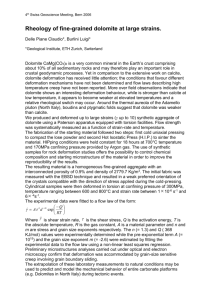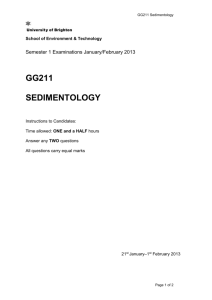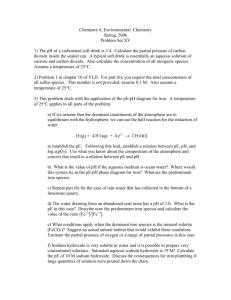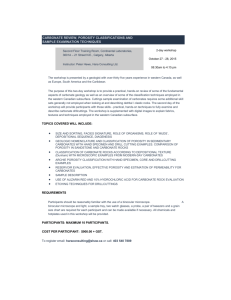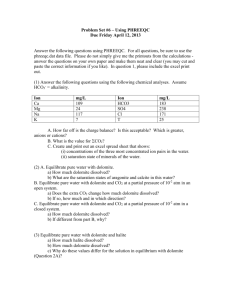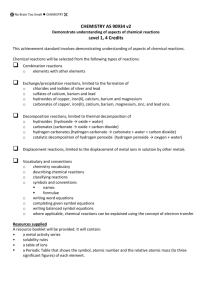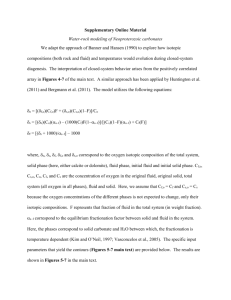THE MINERALOGY, GEOCHEMISTRY, AND METALLURGY OF COBALT IN THE RHOMBOHEDRAL CARBONATES 653 I
advertisement
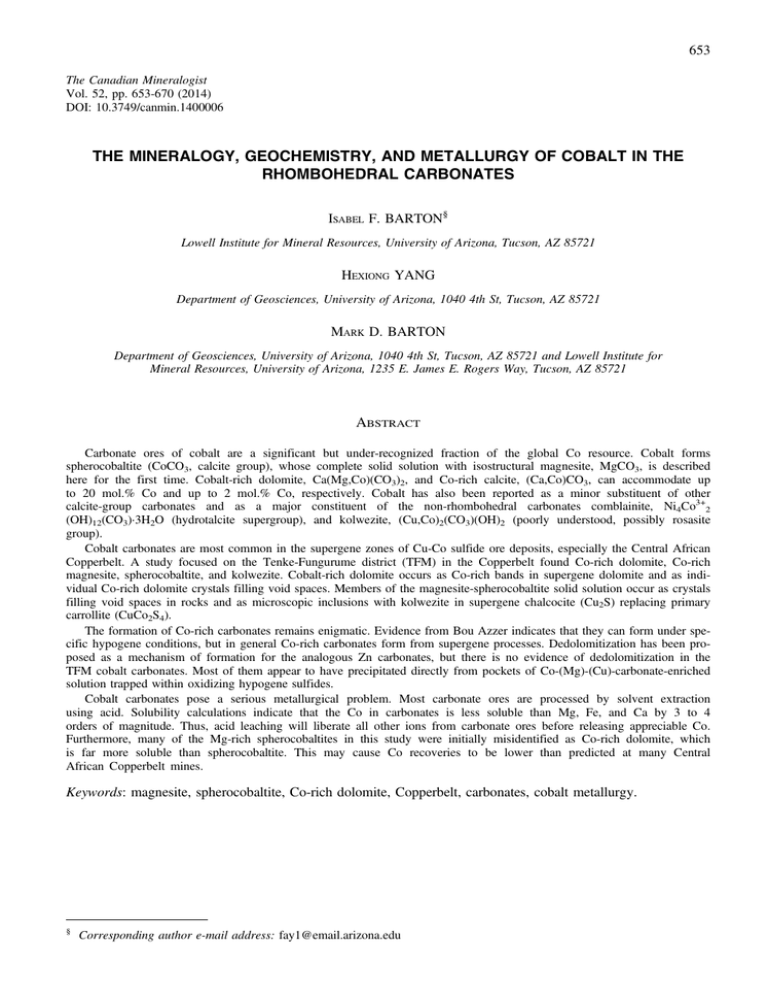
653 The Canadian Mineralogist Vol. 52, pp. 653-670 (2014) DOI: 10.3749/canmin.1400006 THE MINERALOGY, GEOCHEMISTRY, AND METALLURGY OF COBALT IN THE RHOMBOHEDRAL CARBONATES ISABEL F. BARTON§ Lowell Institute for Mineral Resources, University of Arizona, Tucson, AZ 85721 HEXIONG YANG Department of Geosciences, University of Arizona, 1040 4th St, Tucson, AZ 85721 MARK D. BARTON Department of Geosciences, University of Arizona, 1040 4th St, Tucson, AZ 85721 and Lowell Institute for Mineral Resources, University of Arizona, 1235 E. James E. Rogers Way, Tucson, AZ 85721 ABSTRACT Carbonate ores of cobalt are a significant but under-recognized fraction of the global Co resource. Cobalt forms spherocobaltite (CoCO3, calcite group), whose complete solid solution with isostructural magnesite, MgCO3, is described here for the first time. Cobalt-rich dolomite, Ca(Mg,Co)(CO3)2, and Co-rich calcite, (Ca,Co)CO3, can accommodate up to 20 mol.% Co and up to 2 mol.% Co, respectively. Cobalt has also been reported as a minor substituent of other calcite-group carbonates and as a major constituent of the non-rhombohedral carbonates comblainite, Ni4Co3+2 (OH)12(CO3)·3H2O (hydrotalcite supergroup), and kolwezite, (Cu,Co)2(CO3)(OH)2 (poorly understood, possibly rosasite group). Cobalt carbonates are most common in the supergene zones of Cu-Co sulfide ore deposits, especially the Central African Copperbelt. A study focused on the Tenke-Fungurume district (TFM) in the Copperbelt found Co-rich dolomite, Co-rich magnesite, spherocobaltite, and kolwezite. Cobalt-rich dolomite occurs as Co-rich bands in supergene dolomite and as individual Co-rich dolomite crystals filling void spaces. Members of the magnesite-spherocobaltite solid solution occur as crystals filling void spaces in rocks and as microscopic inclusions with kolwezite in supergene chalcocite (Cu2S) replacing primary carrollite (CuCo2S4). The formation of Co-rich carbonates remains enigmatic. Evidence from Bou Azzer indicates that they can form under specific hypogene conditions, but in general Co-rich carbonates form from supergene processes. Dedolomitization has been proposed as a mechanism of formation for the analogous Zn carbonates, but there is no evidence of dedolomitization in the TFM cobalt carbonates. Most of them appear to have precipitated directly from pockets of Co-(Mg)-(Cu)-carbonate-enriched solution trapped within oxidizing hypogene sulfides. Cobalt carbonates pose a serious metallurgical problem. Most carbonate ores are processed by solvent extraction using acid. Solubility calculations indicate that the Co in carbonates is less soluble than Mg, Fe, and Ca by 3 to 4 orders of magnitude. Thus, acid leaching will liberate all other ions from carbonate ores before releasing appreciable Co. Furthermore, many of the Mg-rich spherocobaltites in this study were initially misidentified as Co-rich dolomite, which is far more soluble than spherocobaltite. This may cause Co recoveries to be lower than predicted at many Central African Copperbelt mines. Keywords: magnesite, spherocobaltite, Co-rich dolomite, Copperbelt, carbonates, cobalt metallurgy. § Corresponding author e-mail address: fay1@email.arizona.edu 654 THE CANADIAN MINERALOGIST INTRODUCTION Cobalt worldwide Cobalt is a strategic metal used in high-temperature steels, magnets, lithium-ion batteries, and other industrial applications. It also has medical uses: cobalt is the central atom in vitamin B12 (cobaltamine), and radioactive Co60 is the chief radiation source in cancer therapies. The world’s identified Co resource totals about 15 million metric tons, most of which is accessory in Ni-laterite deposits (Shedd 2013). Historical production has come chiefly from mafic- and ultramafichosted PGE deposits in Russia and Australia, but in recent years the Congolese deposits of the Central African Copperbelt have come to produce more than half the annual global supply of cobalt (Shedd 2013). Other contributions come from Příbram (Czech Republic), Tsumeb (Namibia), Bou Azzer (Morocco), the Flinders Range (Australia), and the Santa Rosalia district (Mexico) (Table 1). Cobalt in rhombohedral carbonates Crystal chemical factors determining cation substitution in carbonates The carbonate structure consists of chains of cation coordination polyhedra sharing O ions. Thus, either each cation polyhedron must be of a shape and size to link up easily with its neighbors, or the neighboring polyhedra must distort to reach it. Highly distorted structures are unstable, so no carbonate can form unless its cation polyhedra require little distortion. The formation of a stable, undistorted structure is most easily achieved in one-cation carbonates such as pure CaCO3 or FeCO3. In these, all the cation coordination polyhedra are the same size and shape and they do not have to distort to link into a chain. However, this is the ideal case: most naturally occurring carbonates contain multiple cation types, and each cation type has a different coordination polyhedron. If all the cation types have coordination polyhedra of similar shape and size, they can link to one another with very little distortion. In this case, the various cation types are distributed over the octahedral sites at random. This is the disordered or calcite structure, in which any cation present can occur at any cation site along the chain (Reeder 1983). But if the cation types have coordination polyhedra of very different sizes and shapes, they cannot link without distorting to a degree that makes the structure unstable. In this case, the carbonate must be stabilized by adopting the ordered or dolomite structure, in which the different cation types are sorted onto different, alternating sites. This alternation accommodates the necessary distortion by distributing it evenly over the chain of polyhedra, such that each polyhedron is stretched a little and none is stretched too much (Navrotsky & Loucks 1977). Cobalt substitution in carbonates In charge and ionic radius (0.745 Å), Co2+ is most similar to octahedral Mg2+ (0.72 Å), Fe2+ (0.78 Å), TABLE 1. REPORTED OCCURRENCES OF COBALT CARBONATE MINERALS Location Tenke-Fungurume, D.R. Congo Przibram, Bohemia Peramea, Spain Durango, Colorado Kakanda, D.R. Congo Mashamba West and Mindingi, D.R. Congo Tantara, D.R. Congo Kamoto, Musonoi, and Kabolela, D.R. Congo Mupine, D.R. Congo Kambove, D.R. Congo Konkola, Zambia Chibuluma, Zambia Tsumeb, Namibia Shinkolobwe, D.R. Congo Reported species Magnesite-spherocobaltite, spherocobaltite, cobaltoan dolomite Cobaltoan dolomite Cobaltoan calcite Kolwezite Cobaltoan dolomite, spherocobaltite Cobaltoan calcite Cobaltoan calcite Spherocobaltite, kolwezite Spherocobaltite, cobaltoan calcite Cobaltoan dolomite Spherocobaltite Cobaltoan dolomite “Cobaltocalcite” – probably spherocobaltite Cobaltoan dolomite Comblainite Reference This work Minceva-Stefanova 1997 Reeder et al. 1999 Daltry 1992 Gauthier & Deliens 1999 Gauthier & Deliens 1999 Gauthier & Deliens 1999 Gauthier & Deliens 1999; Pirard & Hatert 2008 Gauthier & Deliens 1999 Van Langendonck et al. 2013; Gauthier & Deliens 1999 Sweeney et al. 1986 Whyte & Green 1971 Hurlbut 1957 Daltry 1991 cobalt in the rhombohedral carbonates and Mn2+ (0.83 Å) (Shannon 1976). The Co2+ ion has a low-spin d7 configuration and degeneracy in the t2g orbital (Rosenberg & Foit 1979). Distorting the coordination octahedron removes the degeneracy, reducing the energy of the complex (Jahn-Teller effect). Thus, the Co2+ coordination octahedron is compressed relative to the Mg2+ octahedron (Rosenberg & Foit 1979). The Co-bearing carbonates stable in nature (Table 1) reflect these crystal-chemical factors. Cobalt forms a stable calcite-structured carbonate (spherocobaltite, CoCO3; also sphaerocobaltite or cobaltocalcite). Cobalt-rich calcite [(Ca,Co)CO3] is also a recognized mineral, but it cannot contain much Co: Goldsmith & Northrop (1965) found a maximum of 15 mol.% Co in calcites at 800 °C, which dropped to less than 5 mol.% by 600 °C. Katsikopoulos et al. (2008) achieved 16 mol.% Co in low-temperature calcite only by dint of extreme Co-oversaturation in the fluid and mixture with silica gel. Such conditions are not very realistic in the supergene zones of ore deposits, where most Co-carbonates form. Simmonds (1980) observed calcites in the Central African Copperbelt with Co only up to 1.6 mol.%. The transition metal carbonates have extensive solid solutions. The published analytical data for spherocobaltite solid solutions are scanty, but Clissold et al. (2003) detected minor Co in some gaspéite samples. Goldsmith & Northrop (1965) indicated a theoretical complete solid solution between spherocobaltite and magnesite at 600 °C and 15 kbar; this study is the first report of (Mg,Co)CO3 in nature. The solid solutions of magnesite are better documented: magnesite has complete solid solutions with siderite at 250 °C (Anovitz & Essene 1987); with rhodochrosite at and above 500 °C and 10 kbar, and possibly at lower temperature (Goldsmith & Graf 1960); and with otavite at 800 °C and 1 GPa (Bromiley et al. 2007). At lower temperatures, however, a Cddolomite limits the extent of magnesite-otavite solid solution (Bromiley et al. 2007). Other partial solid solutions of magnesite include calcite (Goldsmith & Graf 1960, Mackenzie et al. 1983), gaspéite (Goldsmith & Northrop 1965), and smithsonite (Boni et al. 2011). However, there is no work up to the present on the magnesite-spherocobaltite solid solution below the conditions (600 °C and 15 kbar) at which Goldsmith & Northrop (1965) documented complete solid solution. Cobalt does not form a stable dolomite-structured carbonate, either with other transition metal ions or with Ca2+. All the transition metal ions, including Co2+, have coordination octahedra of similar shape and size, so they can link into a chain with little distortion and have no need to assume any specific order (Reeder 1983). In the case of Ca2+-rich dolomitestructured carbonates, the large Ca2+ ion is near the 655 maximum size for octahedral coordination, and the Ca2+ polyhedron does not distort easily and will not form dolomite-structured carbonates with Co2+ and some of the other transition metals (Rosenberg & Foit 1979). Cobalt may also occur in kolwezite [(Cu,Co)2 (CO3)(OH)2, rosasite group] and in comblainite [Ni4Co2(OH)12(CO3)·3H2O, quintinite group]. Comb‐ lainite is notable as the only carbonate in which cobalt is trivalent. However, these are rare and poorly understood minerals, and their possible Co concentrations and even their crystal systems remain unconstrained (Perchiazzi & Merlino 2006, Frost et al. 2007). Calcite- and dolomite-group carbonates contain the world’s entire economically significant Co carbonate resource. This study began as part of a broader examination of the geology of the Tenke-Fungurume Cu-Co district (TFM) and other deposits on the Congolese side of the Central African Copperbelt. Research there includes work on the mineralogical controls on ore processing, so the metallurgy as well as the mineralogy of the ores are of interest to the overarching geological investigation. COBALT CARBONATES IN THE CENTRAL AFRICAN COPPERBELT Overview: Geological background The Central African Copperbelt of northern Zambia and southeastern D.R. Congo (Fig. 1) is one of the world’s largest Cu and Co resources (Selley et al. 2005) and is a major source for Co-rich carbonate mineral specimens (Gauthier & Deliens 1999). Most Co-rich carbonates are produced during supergene alteration of cobalt sulfide ores, and the Cocarbonates of the Central African Copperbelt are no exception. The Co was originally a part of carrollite (CuCo2S4), which precipitated along with chalcopyrite (CuFeS2), bornite (Cu5FeS4), and digenite (Cu9S5) in a Neoproterozoic basinal carbonate-clastic sequence (the Mines Series of the Roan Group, < 887 Ma; Cailteux 1994). Textural relationships are somewhat ambiguous but tend, overall, to indicate that carrollite precipitated before the Cu-Fe sulfides. However, all the sulfide ores seem to have precipitated during a single alteration episode sometime during diagenesis, accompanied by voluminous dolomitic alteration (Oosterbosch 1951, Schuh et al. 2012). Post-ore quartz replaced some of the dolomite. Further alteration occurred as thin-skinned Pan-African (570– 510 Ma) deformation broke the mineralized rocks into separate “écailles” and pushed them northward into their present arcuate arrangement (Selley et al. 2005). Dating of the Copperbelt’s large, coarsely crystalline, high-angle dolomite veins indicate that they formed 656 THE CANADIAN MINERALOGIST FIG. 1. Map of the Central African Copperbelt, showing the Tenke-Fungurume district. during this period (Barra 2005). Some of the ore sulfides were remobilized into these veins, presumably as the orogeny proceeded (Selley et al. 2005). After the orogeny, erosion exposed the Mines Series rocks to meteoric waters, which dissolved the sulfides and dolomite near the surface. Some of the metals from the sulfides combined with the carbonate from the dolomite to form malachite (Fig. 2). Chrysocolla, heterogenite, pseudomalachite, and rare cornetite, brochantite, and libethenite are also present among the supergene minerals nearest the surface (De Putter et al. 2010, Fay & Barton 2012). At greater depths, the supergene Cu minerals are native copper, chalcocite, and cuprite, and the supergene Co minerals are carbonates. These carbonate ores persist to great depths, in some places >750 m below the surface (Fay & Barton 2012). Description Cobalt-rich dolomite and calcite form euhedral crystals up to a few centimeters long, with either rhombic morphology or crest habits. Both carbonates also occur as fine disseminated crystals. Cobalt-rich dolomite is most common as Co-rich bands in otherwise normal dolomite, optically continuous with the rest of the dolomite crystal. Members of the spherocobaltite-magnesite solid solution (Mg,Co)CO3 form elongate and prismatic crystals with hexagonal cross sections. At up to 1 mm in length, such crystals are the largest and the most noticeable occurrence of (Mg,Co)CO3, which also occurs as inclusions <5 microns across. These inclusions typically consist of magnesian spherocobaltite and kolwezite (Fig. 3). These are common in supergene chalcocite and create the characteristic texture visible in Figure 3. Their pink color distinguishes the Co-bearing from other rhombohedral carbonates (Fig. 3). In hand samples of cobaltoan carbonates, the color is intense even in specimens with less than 5 wt.% Co. In dolomites and calcites the pink tinge is much subtler in thin section, where all but the most Co-rich crystals are only pale pink in plane-polarized light and look no different from ordinary dolomites and calcites with the polars crossed. By contrast, spherocobaltite and compositions along the join towards magnesite retain their intense pink color in thin section. Even in crosspolarized light they have a rosy cast. This intensity of color, and the lack of effervescence even in powdered specimens, distinguishes members of the magnesitespherocobaltite solid solution from the cobaltoan dolomites. All the Co-carbonates are uniaxial, optically negative, and highly birefringent (maximum δ = 0.18). cobalt in the rhombohedral carbonates 657 FIG. 2. Schematic cross sections showing processes of ore formation at Tenke-Fungurume: hypogene sulfide deposition during diagenesis (A) and supergene alteration of the sulfide ores to oxides and carbonates (B). Their Mohs hardnesses are 3.5–4. The presence of Co, and in many cases of Fe, quenches the normally bright cathodoluminescence of a carbonate. Occurrence patterns and abundance Cobalt-rich carbonates are not stable at the surface over most of the Central African Copperbelt but are sometimes present on freshly dug surfaces at a depth of a few meters. The tops of Copperbelt deposits contain Co mostly as heterogenite. The lower depths of deposits contain Co entirely as carrollite. Although minor Co-carbonate concentrations persist some way into the shallow heterogenite and deep carrollite zones, the vast majority of Co-rich carbonate occurs in the middle depths between them. Cobalt carbonate occurrences do not correlate with stratigraphy or with type of gangue, and most of them may be associated with any of the sulfide or oxide ore minerals. The exception is the inclusion type of (Mg,Co)CO3, which follows the distribution of the supergene chalcocite that hosts it. Core loggers and most research geologists generally consider Co-rich dolomite the most abundant of the Co-carbonates in the Copperbelt by far. However, more than a dozen samples recorded as Co-rich dolomite during fieldwork and petrography have proven on reexamination to be Co-rich magnesite or Mg-rich spherocobaltite. Thus, it is likely that much of the pink carbonate recorded in core logs and maps as 658 THE CANADIAN MINERALOGIST FIG. 3. Typical occurrence of Co-rich carbonates at TFM. (A) Kolwezite-cored inclusions of Mg-rich spherocobaltite in a chalcocite grain replacing carrollite, sample F23R-347.05; cc = chalcocite. (B) Crystalline variety of (Mg,Co)CO3 in thin section, plane-polarized transmitted light, sample F65-113.5. (C) The same, in cross-polarized transmitted light. (D) Typical occurrence of Co-carbonate in hand sample F12-200.8. 659 cobalt in the rhombohedral carbonates Co-rich dolomite is in fact (Mg,Co)CO3. This makes it impossible to judge which Co carbonates are most abundant, how abundant they are, and where each may be distributed, except for their collective restriction to the middle depths of ore deposits. Textural relationships to other minerals Cobalt carbonates overgrow or crosscut most of the other minerals in the Copperbelt host rocks and also occupy void spaces left by dissolution of preexisting minerals. Malachite, heterogenite, native copper, chrysocolla, pseudomalachite, brochantite, kolwezite, and libethenite are the only minerals not crosscut or overgrown by the Co-carbonates; they have the same textural relationships as the Co-carbonates and appear to have formed at the same time. This mineral association and textural relationships indicate that the Cocarbonates and other minerals crystallized late in the paragenesis of alteration, probably during supergene circulation. Electron microprobe analyses of TFM Co-rich carbonates Table 2 the Co-rich a Cameca (EPMA) at shows representative compositions of carbonates analyzed in this study using SX100 electron probe microanalyzer the University of Arizona. Table 3 summarizes the analytical conditions, and Table 4 gives the compositions of the standards used during analysis. The analytical results were normalized to a total of 7.0 atoms per formula unit for dolomites and to 5.0 apfu for magnesite-spherocobaltite. These results show that the magnesite-spherocobaltite solid solution is complete even in the low-temperature supergene specimens in this study. The measured compositions range from Co0.81Mg0.15CO3 (Table 2, sample F9-135.9jv) to Mg0.75Co0.24CO3 (Table 2, sample cp-4) with Fe, Mn, and Ca making up the balance of the cation content. Much of this compositional range is present even in single crystals: backscatter imaging with a JEOL 6010LA SEM showed strong com‐ positional zoning concentric around the c-axis of several crystals (Fig. 4). One of them varied from a core of Mg0.49Co0.48CO3 to a rim of Mg0.84Co0.15CO3 (Fig. 5). Most of the Co-rich dolomite specimens analyzed in this study contain less than 2 mol.% Co (Table 2). This is typical for the Copperbelt (Simmonds 1980), although experimental data obtained at high temperature suggest that Co-rich dolomites may contain up to 20 mol.% Co (Goldsmith & Northrop 1965). MincevaStefanova (1997) reported a specimen from an unknown location with 35 mol.% Co. The analyses from TFM include no specimen with such high Co and only a few with significantly elevated Co: for TABLE 2. REPRESENTATIVE CHEMICAL ANALYSES OF CARBONATE MINERALS FROM TENKE-FUNGURUME Sample; mineral1 MgO (wt.%) CaO MnO FeO CoO NiO ZnO SrO CO2* total Mg apfu Ca Mn Fe Co Ni Zn Sr F65-113.5-1; F65-113.5-2; F65-113.5-4; F65-113.5-5; F65-113.5-6; F65-113.5-7; mg-sp ss mg-sp ss mg-sp ss mg-sp ss mg-sp ss mg-sp ss 19.85 0.94 0.27 0.23 36.08 <0.02 0.06 <0.01 43.94 101.37 0.493 0.017 0.004 0.003 0.482 0.000 0.001 0.000 20.60 0.84 0.20 0.21 34.40 <0.02 0.09 <0.01 43.66 100.00 0.515 0.015 0.003 0.003 0.463 0.000 0.001 0.000 32.46 0.12 <0.05# 0.27 19.60 0.03 <0.01 <0.01 47.25 99.73 0.750 0.002 0.001 0.003 0.244 0.000 0.000 0.000 30.88 0.14 <0.05 0.24 21.95 0.02 0.01 <0.01 46.92 100.17 0.719 0.002 0.000 0.003 0.275 0.000 0.000 0.000 31.40 0.12 <0.05 0.13 21.12 0.03 <0.01 <0.01 46.91 99.71 0.731 0.002 0.001 0.002 0.264 0.000 0.000 0.000 29.66 0.40 0.15 0.81 23.38 0.04 0.09 <0.01 47.09 101.61 0.688 0.007 0.002 0.011 0.292 0.000 0.001 0.000 F137239.5; dol F140540.9; dol 21.66 30.65 0.05 0.16 0.03 0.03 0.04 0.02 47.90 100.53 21.38 30.47 BDL 0.09 BDL BDL BDL BDL 47.34 99.27 0.987 1.004 0.001 0.004 0.001 0.001 0.001 0.000 0.986 1.010 0.001 0.002 0.000 0.000 0.000 0.000 660 THE CANADIAN MINERALOGIST TABLE 2 (CONTINUED). REPRESENTATIVE ANALYSES OF CARBONATE MINERALS FROM TENKE-FUNGURUME Sample; mineral1 MgO (wt.%) CaO MnO FeO CoO NiO ZnO SrO CO2* total Mg apfu Ca Mn Fe Co Ni Zn Sr F177F177F177F178F178F17853.9-1; dol 53.9-2; dol 53.9-3; dol 75.9-1; dol 75.9-2; dol 75.9-3; dol 18.12 29.26 0.81 0.93 4.34 0.02 0.02 0.06 46.41 99.96 0.853 0.989 0.022 0.025 0.110 0.000 0.001 0.001 21.89 29.90 <0.05 0.08 0.09 <0.02 <0.01 0.02 47.49 99.46 1.007 0.988 0.001 0.002 0.002 0.000 0.000 0.000 20.96 29.00 0.16 0.66 0.55 BDL BDL 0.90 46.86 99.09 0.977 0.971 0.004 0.017 0.014 0.000 0.000 0.016 21.74 30.66 <0.05 0.05 <0.02 <0.02 <0.01 0.02 47.87 100.34 0.992 1.005 0.001 0.001 0.000 0.000 0.000 0.000 20.93 29.80 0.08 <0.05 1.74 <0.02 0.03 <0.01 47.33 99.91 14.39 29.30 0.06 <0.05 11.41 <0.02 0.02 0.01 45.46 100.65 0.966 0.988 0.002 0.000 0.043 0.000 0.001 0.000 F184-65. 9-1; dol F18465.9-2; dol 21.82 30.53 0.10 0.27 <0.02 <0.02 <0.01 0.01 48.01 100.74 21.54 30.31 0.11 0.22 0.71 <0.02 <0.01 0.02 47.94 100.86 0.691 1.012 0.002 0.000 0.295 0.000 0.000 0.000 0.992 0.998 0.002 0.007 0.000 0.000 0.000 0.000 0.981 0.992 0.003 0.006 0.017 0.000 0.000 0.000 TABLE 2 (CONTINUED). REPRESENTATIVE ANALYSES OF CARBONATE MINERALS FROM TENKE-FUNGURUME Sample; mineral1 F192F264F264F4153.2; dol 167.3B; dol 176.3; dol 66.8; dol F62RF65-113.5- F65-113.52854; dol 8; dol 9; dol MgO (wt.%) CaO MnO FeO CoO NiO ZnO SrO CO2* total 21.47 30.51 0.27 0.57 <0.02 <0.02 0.04 0.02 47.93 100.79 19.75 30.02 0.90 2.47 <0.02 0.01 0.05 0.02 47.24 100.46 Mg apfu Ca Mn Fe Co Ni Zn Sr 0.978 0.999 0.007 0.015 0.000 0.000 0.001 0.000 21.45 30.35 0.12 0.63 <0.02 <0.02 0.02 0.02 47.72 100.32 0.982 0.998 0.003 0.016 0.000 0.000 0.000 0.000 21.58 30.47 0.08 0.24 <0.02 <0.02 0.01 0.02 47.69 100.09 0.988 1.003 0.002 0.006 0.000 0.000 0.000 0.000 21.82 30.34 0.08 0.06 0.03 <0.02 <0.01 0.02 47.76 100.13 0.998 0.997 0.002 0.002 0.001 0.000 0.000 0.000 example, Ca1.01(Mg0.69Co0.29)(CO3)2 (Table 2, sample F178-75.9) and Ca1.02(Mg0.76Co0.21)(CO3)2 (Table 2, sample Kw364-218.4B). No data exist on the composition of kolwezite in the Copperbelt, and the only specimens available at 0.913 0.997 0.024 0.064 0.000 0.000 0.001 0.000 20.22 29.87 0.47 0.67 1.78 <0.02 <0.01 <0.01 47.27 100.28 0.934 0.992 0.012 0.017 0.044 0.000 0.000 0.000 21.74 30.60 <0.05 0.07 <0.02 <0.02 <0.01 <0.01 47.82 100.23 0.993 1.004 0.001 0.002 0.000 0.000 0.000 0.000 F65-113.5-10; mg-sp ss 19.72 0.91 0.24 0.21 36.05 <0.02 0.07 <0.01 43.74 100.95 0.492 0.016 0.003 0.003 0.484 0.000 0.001 0.000 TFM were the kolwezite-magnesian spherocobaltite inclusions, in which the kolwezite proved too small to analyze. No kolwezite amid the inclusions measured more than 10 microns long, and most of them were less than 3 microns in length. 661 cobalt in the rhombohedral carbonates TABLE 2 (CONTINUED). REPRESENTATIVE ANALYSES OF CARBONATE MINERALS FROM TENKE-FUNGURUME Sample; mineral1 MgO (wt.%) CaO MnO FeO CoO NiO ZnO SrO CO2* total Mg apfu Ca Mn Fe Co Ni Zn Sr F65-113.5-11; mg-sp ss F6560.8; dol F9-114.3; dol F9-135.9jv; mg-sp ss 16.66 0.85 0.20 0.30 39.61 <0.02 0.02 <0.01 42.44 100.08 21.49 30.19 0.13 0.63 <0.02 <0.02 0.10 0.04 47.68 100.24 21.56 30.25 0.11 0.32 <0.02 <0.02 <0.01 <0.01 47.56 99.80 5.14 0.55 0.10 1.66 53.09 0.63 0.01 BDL 38.68 99.86 0.429 0.016 0.003 0.004 0.548 0.000 0.000 0.000 0.984 0.994 0.003 0.016 0.000 0.000 0.002 0.001 0.990 0.998 0.003 0.008 0.000 0.000 0.000 0.000 0.145 0.011 0.002 0.026 0.806 0.010 0.000 0.000 Fw82Fw82139.8; dol 145A; dol 21.65 30.23 0.14 0.46 <0.02 <0.02 <0.01 0.01 47.74 100.23 0.990 0.994 0.004 0.012 0.000 0.000 0.000 0.000 21.46 30.32 0.09 0.49 <0.02 <0.02 <0.01 0.02 47.60 99.97 0.985 1.000 0.002 0.013 0.000 0.000 0.000 0.000 K2365125.3; dol Kf284524; mg 20.56 30.68 0.13 0.59 0.02 0.02 0.04 0.03 47.03 99.11 48.07 0.04 0.10 0.14 <0.02 <0.02 <0.01 <0.01 52.66 101.01 0.955 1.024 0.004 0.015 0.001 0.001 0.001 0.000 0.997 0.001 0.001 0.002 0.000 0.000 0.000 0.000 TABLE 2 (CONTINUED). REPRESENTATIVE ANALYSES OF CARBONATE MINERALS FROM TENKE-FUNGURUME Sample; mineral1 MgO (wt.%) CaO MnO FeO CoO NiO ZnO SrO CO2* total Mg apfu Ca Mn Fe Co Ni Zn Sr 1 Kw300Kw364Kw364Kw3651584B; dol 218.4B-1; dol 218.4B-2; dol 154.3A; dol 21.69 30.17 0.15 0.52 0.02 <0.02 0.03 0.01 47.81 100.40 0.991 0.990 0.004 0.013 0.001 0.000 0.001 0.000 21.65 29.95 0.19 0.51 <0.02 <0.02 0.10 0.04 47.65 100.08 0.992 0.986 0.005 0.013 0.000 0.000 0.002 0.001 15.91 29.80 0.05 0.10 8.10 <0.02 <0.01 <0.01 45.62 99.59 0.762 1.025 0.001 0.003 0.209 0.000 0.000 0.000 21.40 30.49 0.10 0.40 BDL BDL 0.03 0.01 47.63 100.06 0.981 1.005 0.003 0.010 0.000 0.000 0.001 0.000 MgCo2 T158core; mg- MgCo2 mid; MgCo2 rim; 159.8B; sp ss mg-sp ss mg-sp ss dol 32.66 0.63 0.17 0.22 19.81 <0.02 0.08 <0.01 48.08 101.64 0.742 0.010 0.002 0.003 0.242 0.000 0.001 0.000 32.04 0.09 <0.05 0.28 20.02 0.02 <0.01 <0.01 47.03 99.48 0.744 0.002 0.001 0.004 0.250 0.000 0.000 0.000 28.74 0.44 <0.05 0.12 25.25 0.04 0.01 <0.01 46.68 101.28 0.672 0.007 0.000 0.002 0.318 0.000 0.000 0.000 21.75 30.33 0.17 0.36 <0.02 <0.02 0.02 0.03 47.90 100.56 0.991 0.994 0.004 0.009 0.000 0.000 0.000 0.001 Mineral abbreviations: mg-sp ss = magnesite-spherocobaltite solid solution; dol = dolomite; mg = magnesite. *CO2 calculated from stoichiometry. *“<”values for the oxides are based on and calculated from 3σ elemental detection limits: Ca 250 ppm; Mn 349 ppm; Fe 348 ppm; Co 134 ppm; Ni 100 ppm; Zn 74 ppm; and Sr 78 ppm. A few Mn apfu values ostensibly below detection limit appear as 0.001 due to rounding errors. 662 THE CANADIAN MINERALOGIST TABLE 3. ANALYTICAL CONDITIONS FOR ELECTRON PROBE MICROANALYZER ANALYSES, CAMECA SX100 Beam Avg. det. current Dwell Voltage Limit Element (nA) time (s) (keV) Detector (ppm) Mg Ca Fe Mn Co Ni Zn Sr 10 10 10 10 100 100 100 100 20 20 20 20 60 60 60 60 20 20 20 20 20 20 20 20 TAP LPET LLIF LLIF TAP LPET LLIF LLIF 459 250 348 349 134 100 74 78 Cobalt-rich calcite was not detected in any TFM sample. X-ray diffraction and Raman spectrum of (Mg,Co)CO3 An 80 μm-long crystal of Co-rich magnesite (Mg0.63Co0.37CO3 based on SEM-EDS analysis) was examined with single-crystal X-ray diffraction using a Bruker X8 APEX2 CCD X-ray diffractometer equipped with graphite-monochromatized MoK radiation. This yielded unit cell parameters a = b = 4.6537(4), c = 15.003(1)Å, and V = 281.38(4) Å3. This unit cell volume is 1.58 Å3 larger than the corresponding weighted average of 63% of the MgCO3 (279.05 Å3) and 37% of the CoCO3 (281.07 Å3) unit cells, which was calculated as 279.80 Å3. However, this volume difference is probably not large enough to destabilize the (Mg,Co)CO3 solid solution at high pressures. The structure determination demonstrates that this Co-magnesite possesses the calcite-type structure (space group R-3c). The Raman spectrum of the same Co-rich magnesite crystal was then collected in a random orientation with a Thermo Almega microRaman system using a 532 nm solid-state laser with a thermoelectric-cooled CCD detector. The laser is partially polarized with 4 cm−1 resolution and a spot size of 1 µm. Comparison with the Raman spectra for magnesite (R050443) and spherocobaltite (R060497) in the RRUFF database (http://rruff.info) reveals that the Raman bands obtained from the Co-magnesite crystal lie intermediate between magnesite and spherocobaltite and have no extraneous peaks (Fig. 6). Similar results have been observed for the magnesite-siderite solid solutions (Boulard et al. 2012), indicating that Co affects the structures of calcite-type carbonates in a way similar to Fe and other transition metals in carbonate solid solution. DISCUSSION Inferred Mg–Ca–Co carbonate phase relations at low T The only existing chemical data for the MgCO3– CoCO3 system are from samples synthesized at 600– 800 °C and 15–25 kbar and these indicate complete solid solution (Goldsmith & Northrop 1965). The Raman spectrum, X-ray diffraction data, and chemical compositions in this study (Fig. 7) show that a complete solid solution between magnesite and spherocobaltite persists to the pressure-temperature conditions of the supergene environment—probably near-surface pressure and temperature < 50 °C. Figure 8 shows the inferred phase relations among Mg, Co, and Ca carbonates in this pressure-temperature regime. The maximum possible concentration of Co in dolomite is uncertain, but the present study analyzed dolomites with as much as 8.9 mol.% Co (11.41% CoO; Table 2, sample F178-75.9). Goldsmith & Northrop (1965) calculated a theoretical limit of 20% Co. TABLE 4. COMPOSITIONS OF ELECTRON MICROPROBE STANDARDS USED IN ANALYSES (wt.%) Element/ Mg / Standard MgCO3 Mg Ca Fe Mn Co Ni Zn Sr Ca / CaCO3 Fe / FeCO3 Mn / MnCO3 28.44 0.04 40.09 0.68 0.02 0.57 10.49 8.62 0.02 16.8 17.87 45.92 0.17 2.28 46.66 Ni / Ni- Co / CoAl diopside diopside 24.68 24.91 0.45 0.12 1.13 1.36 Si Zn / ZnO Sr / SrCO3 C O 14.19 12.01 10.34 10.51 56.74 48 41.36 42.02 43.06 43.01 19.77 32.97 4.91 5.06 79.45 57.22 8.25 cobalt in the rhombohedral carbonates 663 FIG. 4. Crystalline variety of magnesite-spherocobaltite solid solution, in backscatter, showing zoning within crystals. Sample F65-113.5, BSE image of Figure 3B-3C. FIG. 5. Comparison of backscatter image of Co-rich magnesite (mag-sphc) with compositions determined by EPMA at marked points 1–7. Sample F65-113.5-1 through F65-113.5-7 in Table 2; F65-113.5-3 was excluded from the Table due to a poor total. 664 THE CANADIAN MINERALOGIST FIG. 6. Raman spectra of spherocobaltite, magnesite, and a member of the magnesite-spherocobaltite solid solution. FIG. 7. Ca–Co–Mg-carbonate ternary diagram showing compositions of species analyzed in this study. Formation of Co-bearing carbonates The textural evidence cited above renders it virtually certain that the Co-carbonates at TFM formed in the supergene environment as circulating meteoric fluids dissolved dolomite and oxidized the sulfide ores, releasing metal ions. Some of the liberated Co was oxidized Co3+, which formed heterogenite; some of the Co remained divalent and bonded with the carbonate in the fluid, precipitating dolomite, Co-rich dolomite, Co-rich magnesite, and magnesian spherocobaltite. The following section cobalt in the rhombohedral carbonates will focus on the potential precipitation mechanisms of each of these in turn. Dolomite precipitation at low temperature is a vexed issue in the geochemical and geological literature (e.g., Baker & Kastner 1981, Land 1998, Warren 2000), and most explanations of low-temperature dolomite formation involve dolomitization of a preexisting calcite during diagenesis of sedimentary rock (e.g., Hardie 1987). However, this is not a viable mechanism for producing the supergene Co-rich dolomite as observed at TFM. Cobalt would be evenly distributed through dolomite crystals produced by dolomitization of a calcite, whereas in the TFM samples, Co-rich dolomite occurs as high-Co bands in normal Ca-Mg dolomites. Primary precipitation of a variably Co-rich dolomite offers the best explanation for this banded character, even though primary precipitation of dolomite remains problematic from a kinetic standpoint (Lovering 1969). Under this hypothesis, the high-Co bands represent transient episodes of Co enrichment in the dolomite-precipitating fluid, probably a result of dissolution of nearby carrollite. Such a fluid must also have been considerably enriched in Mg relative to Ca, as dolomite cannot precipitate from a fluid with Mg/Ca < 5.2 (Warren 2000). The possible mechanisms for supergene origin of such an Mg-enriched fluid are enigmatic. Potential formation mechanisms of the magnesian spherocobaltites are even less clear. Boni et al. (2011) have textural evidence that Mg-rich smithsonite in the Jabali deposit (Yemen), analogous to the Mg-rich spherocobaltites at TFM, formed by dedolomitization of a Zr-rich dolomite. Dedolomitization is a common geological phenomenon, especially in the supergene environment (Dockal 1988). It consists of ion exchange: CaMgðCO3 Þ2 þ Ca2þ ¼ 2CaCO3 þ Mg2þ ¼ 10Ca2þ þ 20Mg0:7 Co0:3 CO3 ð3Þ The added Co and Mg might come from dissolving nearby carrollite and dolomite. Significantly, Equation (3) demonstrates that adding equal proportions of Co and Mg results in Co enrichment in the magnesite relative to the parent Co-rich dolomite. The composition of the magnesite produced by Equation (3) is similar to the composition of many or most of the cobaltoan magnesites observed at TFM (Table 2). From a geochemical point of view, Equation (3) offers a plausible explanation for the formation of the magnesite-spherocobaltite solid solution at TFM. However, the textural evidence contradicts it: the (Mg,Co)CO3 crystals at TFM occur on dolomite grains that show no evidence of dissolution (Fig. 4). Still, dedolomitization might have been very localized, or might have occurred elsewhere and the components transported to the site of supergene magnesite-spherocobaltite. Figure 8 shows a possible pathway for fluid and crystal following dedolomitization of a cobaltoan dolomite. The kolwezite-(Mg,Co)CO3 inclusions common in supergene chalcocite are more likely to have formed by direct precipitation from pockets of Mg-Cu-Cocarbonate fluid trapped within the chalcocite grain as it replaced carrollite. The observation that kolwezite is invariably at the centers of the inclusions and (Mg,Co)CO3 is invariably at the edges suggests that (Mg,Co)CO3 precipitated first. Crystallization of magnesian spherocobaltite proceeded either until Mg was exhausted or until Cu reached saturation in the remaining fluid, which then crystallized kolwezite (Fig.3). A possible reaction is: ð1Þ CaMgðCO3 Þ2 þ CuCo2 S4 þ 4H2 O þ CO2 þ 7:5O2 ¼ 3H2 SO4 þ CuCoðCO3 ÞðOHÞ2 þ 2ðMg; CoÞCO3 þ CaSO4ðaqÞ ð4Þ ð2Þ Equation (4) is balanced for Mg0.5Co0.5CO3, although the compositions of the inclusions are typically closer to spherocobaltite. An equation for endmember spherocobaltite might be: or CaMgðCO3 Þ2 þ Mg2þ ¼ 2MgCO3 þ Ca2þ 10CaðMg0:9 Co0:1 ÞðCO3 Þ2 þ 5Co2þ þ 5Mg2þ 665 Dedolomitization by Equation (1) occurs at low aMg2+/aCa2+ (Rosenberg et al. 1967) and produces calcite plus an Mg-enriched fluid. Dedolomitization by Equation (2) is less common and, for a pure Ca-Mg dolomite, produces magnesite plus a Ca-enriched fluid. If, however, the dolomite contains appreciable transition metals at the Mg site, dedolomitization by Equation (2) generates magnesite solid solutions rather than end-member magnesite (Boni et al. 2011). Thus, analogy with the Zn-carbonate system would suggest that (Mg,Co)CO3 can form by dedolomitization of a cobaltoan dolomite: 3CuCo2 S4 þ 6CO2 þ 12H2 O þ 20O2 ¼ CuCoðCO3 ÞðOHÞ2 ð5Þ þ 5CoCO3 þ Cu2 S þ 11H2 SO4 Equations (3)–(5) are all potentially viable methods for producing magnesite-spherocobaltite solid solution in the supergene environment, although there are objections to Equation (3) based on the textural evidence cited above. Any or all of the processes represented by these equations may have contributed to forming magnesite-spherocobaltite solid solution at 666 THE CANADIAN MINERALOGIST FIG. 8. Ternary diagram showing the inferred phase relations among Ca-Mg-Co carbonates at supergene pressure-temperature conditions, the minerals stable in fluids of different compositions, and one potential way to form magnesite-spherocobaltite solid solution by dedolomitization of a Co-rich dolomite. TFM, and the present evidence is not enough to judge their relative roles. Although they are best known from the supergene zones of Central African Copperbelt deposits, Co-rich carbonates can form in the hypogene environment. A specimen from Bou Azzer (Morocco) contains Corich dolomite intergrown with primary skutterudite (CoAs3). This indicates that Co carbonates can precipitate under hypogene conditions. Hypogene Cocarbonate precipitation is probably limited to systems that are deficient in As and S relative to Co and CO3; otherwise, Co sulfides, arsenides, and arsenates precipitate. This is consistent with the finding of Markl et al. (2014) that spherocobaltite and cobaltoan calcite are unstable with respect to erythrite (Co3AsO4·8H2O) if even the tiniest amount of As is present in solution. Solubility and metallurgical implications The solubilities of rhombohedral carbonates are highly variable (Railsback 1999). Solubility calculations for dolomite, calcite, magnesite, and spherocobaltite show that spherocobaltite is insoluble compared to the Ca and Mg carbonates. Furthermore, in members of carbonate solid solutions such as (Mg,Co)CO3, the cations present are not all liberated at the same rate when the mineral begins to dissolve; some cations enter solution more readily than the others. Solubility calculations for dolomite, magnesite, calcite, and spherocobaltite show that in all of them, Ca2+ and Mg2+ enter solution more readily than Co2+; the difference is three to four orders of magnitude (Fig. 9). Any acid added to a mixed Ca-Co or Mg-Co carbonate will liberate all the available Ca or Mg before it liberates almost any of the Co. This is unfortunate from a metallurgical standpoint: it means that processing acid will dissolve every Ca-Mg carbonate in the vicinity and every other major cation in the Ca-Co or Mg-Co carbonate before it liberates appreciable Co. Cobalt recoveries from carbonate ores in the Copperbelt are predicted with the assumption that the ore is Co-rich dolomite. As detailed above, reexamination of supposed Co-rich dolomite samples from TFM demonstrated that many of them are (Mg,Co)CO3. It is reasonable to think that members of 667 cobalt in the rhombohedral carbonates FIG. 9. Graph showing the log of the concentrations of the ions produced in reactions among the various carbonates. Cobalt is by far the least soluble ion in every reaction involving it. Calculated based on log K values from Robie & Hemingway (1995). cc = calcite, cdol = cobaltoan dolomite, dol = dolomite, mag = magnesite, sphc = spherocobaltite. the magnesite-spherocobaltite solid solution may be present at other Copperbelt deposits and may have been recorded as Co-rich dolomite there, too. Inasmuch as Co in Mg-rich spherocobaltite is less amenable to acid leaching than Co in Co-rich dolomite, such misidentification could cause Co recoveries from Copperbelt ores to be significantly lower than predicted. Without more data on the occurrence and abundance of magnesite-spherocobaltite solid solution, however, it is impossible to say whether this represents a major cause of low recovery. Additional and regional-scale work on the distribution and abundance of the various Co carbonate species is needed. CONCLUSIONS Several carbonates of the calcite and dolomite groups contain appreciable Co: Co-rich dolomite, Corich calcite, spherocobaltite, and the solid solution of spherocobaltite and magnesite-spherocobaltite. Though they can form under hypogene conditions, Co-rich carbonates are more common in the supergene zones of Co ore deposits, where Cu-Co sulfides oxidize. In some cases, Co-rich dolomite and magnesian spherocobaltite are almost surely the products of primary precipitation; however, dedolomitization of Co-dolomite is another potential mechanism for creating (Mg,Co)CO3. Solubility calculations suggest that Co carbonate ores will release all their contained Ca, Mg, and Fe ions before any significant Co when processed by acid leaching. ACKNOWLEDGMENTS The authors appreciate helpful reviews by Stan Evans, Eric Seedorff, Frank Mazdab, Frédéric Hatert, Simon Philippo, and an anonymous reviewer. Frank Mazdab also helped with the microprobe work and mineral normalizations. Research is supported by Freeport-McMoRan Copper & Gold and its affiliate Tenke-Fungurume Mine. REFERENCES ANOVITZ, L.M. & ESSENE, E.J. (1987) Phase equilibria in the system CaCO3–MgCO3–FeCO3. Journal of Petrology 28, 389–414. BAKER, P.A. & KASTNER, M. (1981) Constraints on the formation of sedimentary dolomite. Science 213, 214–216. 668 THE CANADIAN MINERALOGIST BARRA, F. (2005) Multi-stage and long-lived mineralization in the Zambian Copperbelt: Evidence from Re-Os geochronology. In Applications of the Re-Os Isotopic System in the Study of Mineral Deposits: Geochronology and Source of Metals. Unpublished Ph.D. thesis, University of Arizona, 211p. BONI, M., MONDILLO, N., & BALASSONE, G. (2011) Zincian dolomite: A peculiar dedolomitization case? Geology 39, 183–186. BOULARD, E., GUYOT, F., & FIQUET, G. (2012) The influence on Fe content on Raman spectra and unit cell parameters of magnesite-siderite solid solutions. Physics and Chemistry of Minerals 39, 239–246. BROMILEY, F.A., BOFFA BALLARAN, T., LANGENHORST, F., & SEIFERT, F. (2007) Order and miscibility in the otavitemagnesite solid solution. American Mineralogist 92, 829–836. CAILTEUX, J. (1994) Lithostratigraphy of the Neoproterozoic Shaba-type (Zaire) Roan Supergroup and metallogenesis of the associated stratiform mineralization. Journal of African Earth Sciences 19, 279–301. CLISSOLD, M.E., LEVERETT, P., & WILLIAMS, P.A. (2003) Gaspéite-magnesite solid solutions and their significance. In Advances in Regolith (I.C. Roach, ed.). University of Western Sydney, Penrith South DC NSW, Australia (78–79). DALTRY, V.D.C. (1991) African type-mineralogy: a general review (1838–1988). Journal of African Earth Sciences 13, 313–322. DALTRY, V.D.C. (1992) The type mineralogy of Africa: Zaire. Annales de la Société géologique de Belgique 115, 33–62. DE PUTTER, T., MEES, F., DECREE, S., & DEWAELE, S. (2010) Malachite, an indicator of major Pliocene Cu remobilization in a karstic environment (Katanga, Democratic Republic of Congo). Ore Geology Reviews 38, 90–100. DOCKAL, J. (1988) Thermodynamic and kinetic description of dolomitization of calcite and calcitization of dolo‐ mite (dedolomitization). Carbonates and Evaporites 3, 125–141. FAY, I. & BARTON, M. (2012) Alteration and ore distribution in the Proterozoic Mines Series, Tenke-Fungurume Cu– Co district, Democratic Republic of Congo. Mineralium Deposita 47, 501–519. FROST, R.L., WAIN, D.L., MARTENS, W.N., & REDDY, B.J. (2007) The molecular structure of selected minerals of the rosasite group – An XRD, SEM and infrared spectroscopy study. Polyhedron 26, 275–283. GAUTHIER, G. & DELIENS, M. (1999) Cobalt minerals of the Katanga Crescent, Congo. Mineralogical Record 30, 255–267. GOLDSMITH, J.R. & GRAF, D.L. (1960) Subsolidus relations in the system CaCO3–MgCO3–MnCO3. Journal of Geology 68, 324–335. GOLDSMITH, J.R. & NORTHROP, D.A. (1965) Subsolidus phase relations in the systems CaCO3–MgCO3–CoCO3 and CaCO3–MgCO3–NiCO3. Journal of Geology 73, 817–829. HARDIE, L.A. (1987) Dolomitization: a critical view of some current views. Journal of Sedimentary Research 57, 166–183. HURLBUT, C.S. (1957) Zincian and plumbian dolomite from Tsumeb, South-West Africa. American Mineralogist 42, 798–803. KATSIKOPOULOS, D., FERNANDEZ-GONZALEZ, A., CARMELO PRIETO, A., & PRIETO, M. (2008) Co-crystallization of Co (II) with calcite: Implications for the mobility of cobalt in aqueous environments. Chemical Geology 254, 87–100. LAND, L.S. (1998) Failure to precipitate dolomite at 25˚ C from dilute solution despite 1000-fold oversaturation after 32 years. Aquatic Geochemistry 4, 361–368. LOVERING, T.S. (1969) The origin of hydrothermal and low temperature dolomite. Economic Geology 64, 743–754. MACKENZIE, F.T., BISCHOFF, W.D., BISHOP, F.C., LOIJENS, M., SCHOONMAKER, J., & WOLLAST, R. (1983) Magnesian calcites: Low-temperature occurrence, solubility and solid-solution behavior. In Carbonates: Mineralogy and Chemistry (R.J. Reeder, ed.). Reviews in Mineralogy and Geochemistry 11, 97–144. MARKL, G., MARKS, M., DERREY, I., & GUEHRING, J.-E. (2014) Weathering of cobalt arsenides: Natural assemblages and calculated stability relations among secondary Ca–Mg–Co arsenates and carbonates. American Minera‐ logist 99, 44–56. MINCEVA-STEFANOVA, J. (1997) First finding of high miscibility in the system CaMg(CO3)2–CaCo(CO3)2 in nature. Geokhimiya, Mineralogiya i Petrologiya 32, 5–16. NAVROTSKY, A. & LOUCKS, D. (1977) Calculation of subsolidus phase relations in carbonates and pyroxenes. Physics and Chemistry of Minerals 1, 109–127. OOSTERBOSCH, R. (1951) Copper mineralization in the Fungurume region, Katanga. Economic Geology 46, 121–148. PERCHIAZZI, N. & MERLINO, S. (2006) The malachite-rosasite group: crystal structures of glaukosphaerite and pokrovskite. European Journal of Mineralogy 18, 787–792. PIRARD, C. & HATERT, F. (2008) The sulfides and selen‐ ides of the Musonoi mine, Kolwezi, Katanga, Demo‐ cratic Republic of Congo. Canadian Mineralogist 46, 219–231. cobalt in the rhombohedral carbonates RAILSBACK, L.B. (1999) Patterns in the compositions, properties, and geochemistry of carbonate minerals. Carbonates and Evaporites 14, 1–20. REEDER, R.J. (1983) Crystal chemistry of the rhombohedral carbonates. In Carbonates: Mineralogy and Chemistry (R.J. Reeder, ed.). Reviews in Mineralogy and Geo‐ chemistry 11, 1–47. REEDER, R.J., LAMBLE, G.M., & NORTHRUP, P.A. (1999) XAFS study of the coordination and local relaxation around Co2+, Zn2+, Pb2+, and Ba2+ trace elements in calcite. American Mineralogist 84, 1049–1060. ROBIE, R.A. & HEMINGWAY, B.S. (1995) Thermodynamic properties of minerals and related substances at 298.15 K and 1 bar (105 Pascals) pressure and at higher temperatures. Bulletin of the U.S. Geological Survey 2131, 461p. ROSENBERG, P.E. & FOIT, F.F. (1979) The stability of transition metal dolomites in carbonate systems: a discussion. Geochimica Cosmochimica Acta 43, 951–955. ROSENBERG, P.E., BURT, D.M., & HOLLAND, H.D. (1967) Calcite-dolomite-magnesite stability relations in solutions: the effect of ionic strength. Geochimica Cosmochimica Acta 31, 391–396. SCHUH, W., LEVEILLE, R., FAY, I., & NORTH, R. (2012) Geology of the Tenke-Fungurume sediment-hosted stratabound copper-cobalt district, Katanga, Democratic Republic of Congo. In Geology and genesis of major copper deposits and districts of the world: A tribute to Richard H. Sillitoe (J.W. Hedenquist, M.O. Harris, & F. Camus, eds.). Society of Economic Geologists Special Publication 16, 269–301. SELLEY, D., BROUGHTON, D., SCOTT, R., HITZMAN, M., BULL, S.W., LARGE, R.R., MCGOLDRICK, P.J., CROAKER, M., POLLINGTON, N., & BARRA, F. (2005) A new look at the 669 geology of the Zambian Copperbelt. In Economic Geology 100th Anniversary Volume (J.W. Hedenquist, J.F.H. Thompson, R.J. Goldfarb, & J.P. Richards, eds.). Society of Economic Geologists,Colorado, United States (965–1000). SHANNON R.D. (1976) Revised effective ionic radii and systematic studies of interatomic distances in halides and chalcogenides. Acta Crystallographica A32, 751–767. SHEDD, K. (2013) Cobalt. U.S.G.S. Mineral Commodity Summaries, January 2013, 46–48. SIMMONDS, J.R. (1980) Significance of the Baluba orebodies with respect to Zambian copper-cobalt mineralization. Unpublished Ph.D. thesis, University of Wales, 477p. SWEENEY, M., TURNER, P., & VAUGHAN, D.J. (1986) Stable isotope and geochemical studies of the role of early diagenesis in ore formation, Konkola Basin, Zambian Copper Belt. Economic Geology 81, 1838–1852. VAN LANGENDONCK, S., MUCHEZ, P., DEWAELE, S., KAPUTO KALUBI, A., & CAILTEUX, J. (2013) Petrographic and mineralogical study of the sediment-hosted Cu–Co ore deposit at Kambove West in the central part of the Katanga Copperbelt (DRC). Geologica Belgica 16, 91–104. WARREN, J. (2000) Dolomite: occurrence, evolution and economically important associations. Earth-Science Reviews 52, 1–81. WHYTE, R.J. & GREEN, M.E. (1971) Geology and palaeogeography of Chibuluma West Orebody, Zambian Copperbelt. Economic Geology 66, 400–424. Received January 15, 2014, revised manuscript accepted August 5, 2014.

